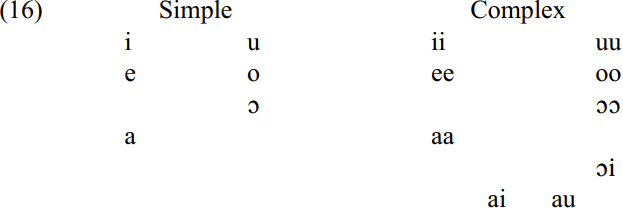

Grammar


Tenses


Present

Present Simple

Present Continuous

Present Perfect

Present Perfect Continuous


Past

Past Simple

Past Continuous

Past Perfect

Past Perfect Continuous


Future

Future Simple

Future Continuous

Future Perfect

Future Perfect Continuous


Parts Of Speech


Nouns

Countable and uncountable nouns

Verbal nouns

Singular and Plural nouns

Proper nouns

Nouns gender

Nouns definition

Concrete nouns

Abstract nouns

Common nouns

Collective nouns

Definition Of Nouns

Animate and Inanimate nouns

Nouns


Verbs

Stative and dynamic verbs

Finite and nonfinite verbs

To be verbs

Transitive and intransitive verbs

Auxiliary verbs

Modal verbs

Regular and irregular verbs

Action verbs

Verbs


Adverbs

Relative adverbs

Interrogative adverbs

Adverbs of time

Adverbs of place

Adverbs of reason

Adverbs of quantity

Adverbs of manner

Adverbs of frequency

Adverbs of affirmation

Adverbs


Adjectives

Quantitative adjective

Proper adjective

Possessive adjective

Numeral adjective

Interrogative adjective

Distributive adjective

Descriptive adjective

Demonstrative adjective


Pronouns

Subject pronoun

Relative pronoun

Reflexive pronoun

Reciprocal pronoun

Possessive pronoun

Personal pronoun

Interrogative pronoun

Indefinite pronoun

Emphatic pronoun

Distributive pronoun

Demonstrative pronoun

Pronouns


Pre Position


Preposition by function

Time preposition

Reason preposition

Possession preposition

Place preposition

Phrases preposition

Origin preposition

Measure preposition

Direction preposition

Contrast preposition

Agent preposition


Preposition by construction

Simple preposition

Phrase preposition

Double preposition

Compound preposition

prepositions


Conjunctions

Subordinating conjunction

Correlative conjunction

Coordinating conjunction

Conjunctive adverbs

conjunctions


Interjections

Express calling interjection

Phrases

Sentences


Grammar Rules

Passive and Active

Preference

Requests and offers

wishes

Be used to

Some and any

Could have done

Describing people

Giving advices

Possession

Comparative and superlative

Giving Reason

Making Suggestions

Apologizing

Forming questions

Since and for

Directions

Obligation

Adverbials

invitation

Articles

Imaginary condition

Zero conditional

First conditional

Second conditional

Third conditional

Reported speech

Demonstratives

Determiners


Linguistics

Phonetics

Phonology

Linguistics fields

Syntax

Morphology

Semantics

pragmatics

History

Writing

Grammar

Phonetics and Phonology

Semiotics


Reading Comprehension

Elementary

Intermediate

Advanced


Teaching Methods

Teaching Strategies

Assessment
Jamaican English The main vowels
المؤلف:
Hubert Devonish and Otelemate G. Harry
المصدر:
A Handbook Of Varieties Of English Phonology
الجزء والصفحة:
459-27
2024-04-05
1324
Jamaican English
The main vowels
Below, we present our proposals for the vowel system of JamE.

We propose here that JamE has 15 vowels. These are made up of six simple vowels. The three features necessary to describe these involve

Redundantly, every vowel with the feature [back] also has the feature [labial].
There are nine complex vowels in JamE, six of these being double vowels. Each simple vowel has a complex counterpart in the form of a long or double version of itself, i.e. /ii/, /ee/, /aa/, /ɔɔ/ , /oo/ and /uu/. This introduces length or doubling as a feature which is characteristic of JamE complex nuclei. The remaining three complex vowels are diphthongs, rising from a low or lower-mid vowel to a high vowel. The first vowel element is always one of the two Low vowels, either /a/ or /ɔ/.
Wells (1973: 25) proposes that JamE has 16 vowels. His sixteenth vowel, /ɔɔ/, is treated by us as an allophone of /o/ when this vowel occurs before a tautosyllabic /r/.

The length feature implicit in our vowel inventory does not match the approach of Meade (2001: 42) to JamE vowels. He suggests that the main phonetic feature distinguishing between short vowels and long monophthongs was tenseness, with the short ones being lax and the long ones tense. This position, on the face of it, seems justified by the fact that, in JamE, much more so than in JamC, the non-low long vowels differ from their short equivalents not just in length but in height and tenseness. The long non-low vowels are always higher and tenser than their short equivalents. Whatever the merits of Meade’s approach for JamE, there is contradicting evidence. This involves the relationship between the third pair of vowels, /a/ and /aa/, in which no height or tense differences are involved. Length is the sole distinguishing feature here. Thus, if one is seeking to find a feature which distinguishes all short vowels in JamE from all long monophthongs, then tenseness versus laxness would not do the job but length would. It is on these grounds that we single out length as the primary distinction between these pairs, with relative height and tenseness being secondary, predictable features of the distinction in the case of the non-low vowels. This approach is much more economical than that of Meade (2001: 42) which proposes that tenseness is the primary feature for the non-low pairs of vowels, and length the primary one for the low pair.
 الاكثر قراءة في Phonology
الاكثر قراءة في Phonology
 اخر الاخبار
اخر الاخبار
اخبار العتبة العباسية المقدسة

الآخبار الصحية















 قسم الشؤون الفكرية يصدر كتاباً يوثق تاريخ السدانة في العتبة العباسية المقدسة
قسم الشؤون الفكرية يصدر كتاباً يوثق تاريخ السدانة في العتبة العباسية المقدسة "المهمة".. إصدار قصصي يوثّق القصص الفائزة في مسابقة فتوى الدفاع المقدسة للقصة القصيرة
"المهمة".. إصدار قصصي يوثّق القصص الفائزة في مسابقة فتوى الدفاع المقدسة للقصة القصيرة (نوافذ).. إصدار أدبي يوثق القصص الفائزة في مسابقة الإمام العسكري (عليه السلام)
(نوافذ).. إصدار أدبي يوثق القصص الفائزة في مسابقة الإمام العسكري (عليه السلام)


















